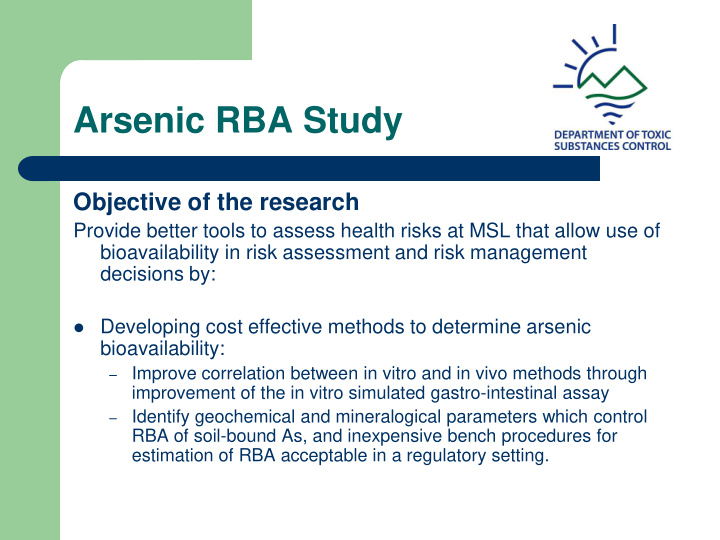



Arsenic RBA Study Objective of the research Provide better tools to assess health risks at MSL that allow use of bioavailability in risk assessment and risk management decisions by: Developing cost effective methods to determine arsenic bioavailability: Improve correlation between in vitro and in vivo methods through – improvement of the in vitro simulated gastro-intestinal assay Identify geochemical and mineralogical parameters which control – RBA of soil-bound As, and inexpensive bench procedures for estimation of RBA acceptable in a regulatory setting.
Arsenic RBA Study Objective cont. Identifying wet chemical, spectroscopic, and physical measurements to use in characterizing MSL Developing a database of mine wastes and corresponding in vitro and mineralogy data Establishing a methodology for implementation at sites other than EMSHP Developing a guidance document for use of bioavailability at MSL
Arsenic RBA Study First Sampling Event Sampling done 9/21-9/23 Total of 25 individual samples in 46 five gallon containers collected As concentrations ranged from 9-9,700 ppm Sample processing at OSU prior to distribution to investigators
Arsenic RBA Study
Arsenic RBA Study Dr. Valerie Mitchell with HERO presented a poster entitled “Identifying Predictors for Bioavailability of Arsenic in Soil at Mining Sites” at the 49th Annual Meeting of the Society of Toxicology in March 2010. Has submitted an abstract for a poster presentation at SOT in March 2011.
Arsenic RBA Study Soil Processing at OSU Homogenization by tumbling for an extended period in a mixer. Sieved on a shaker table and the 250 µm fraction is split and tested for homogeneity. Homogeneity evaluation includes taking a total of 24 subsamples from each homogenized sample and testing each subsample for total arsenic using USEPA Method 3051a. Need ~ 3.5 kgs of 250 µm fraction for each sample. Most samples yielding 15-20 % but a few were <5%.
Arsenic RBA Study
Arsenic RBA Study
Arsenic RBA Study
Arsenic RBA Study Synchrotron and QEMSCAN Thin sections prepared from rock samples collected by T. Burlak during Sampling Event 1 were analyzed at SSRL and University of Utah. Purpose is to understand the progression of weathering, particularly the role of Fe-Mg carbonate minerals in controlling the type of Fe (hydr)oxide that forms when arsenic-bearing sulfides weather.
Arsenic RBA Study “An SEM on Steroids” • Four high-speed energy dispersive detectors collect and combine element x-ray data to identify minerals • Thousands of high-res images can be collected very rapidly • Images created by collecting 1000- count EDAX (Energy Dispersive X- Ray Analysis) spectra on each analysis spot • Scanning a typical thin section can take a couple hours depending on the resolution • Can detect fine grained materials down to 1 micron • Statistical evaluation of data used to quantitatively characterize rock mineralogy (95% confidence interval) http://web.srv.cmes.utah.edu:8080/geo/research/Research_facilities/Qemscan
Arsenic RBA Study Carbon Coated Thin Sections Loaded into Stage Holder -Carbon coat to help prevent stray X- rays from sampling nearby areas and interfering with analysis of desired point -Stages available for round epoxy plugs as well as thin sections -Thin section stage includes gold and quartz samples so beam can recalibrate every 30-40 mins or so http://web.srv.cmes.utah.edu:8080/geo/research/Research_facilities/Qemscan
Arsenic RBA Study A6-B-B Erich Petersen, University of Utah Optical Optical- -RL RL BSE Qemscan Qemscan 5 µ m - 22x3 mm V2.0
Arsenic RBA Study A10-G-C Erich Petersen, University of Utah The As Map shows in green all areas that contained measureable As. The As- rich areas consist of arsenopyrite (see next slides) and As-rich iron oxides that are forming due to the weathering of arsenopyrite. Au 0 BSE As Map 5 µ m - 3x3 mm BSE V2.0
Arsenic RBA Study Questions
Recommend
More recommend